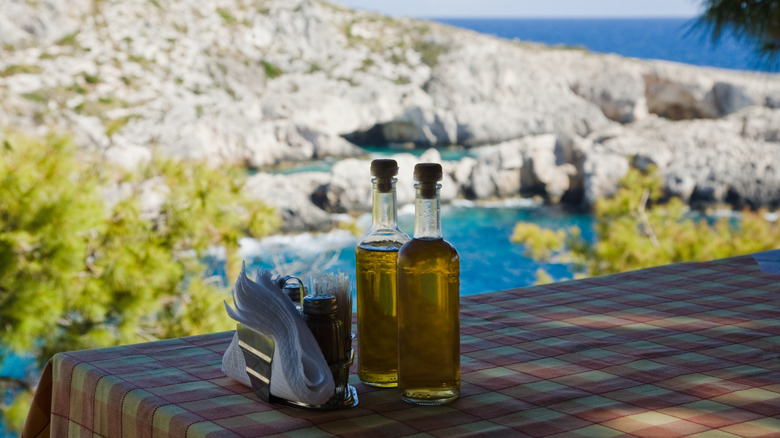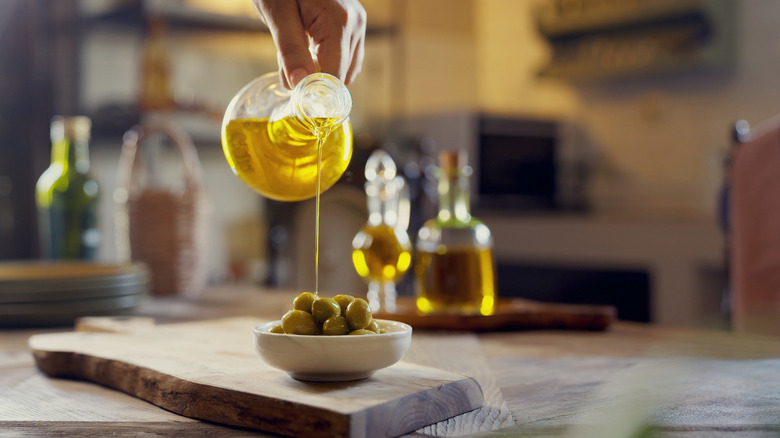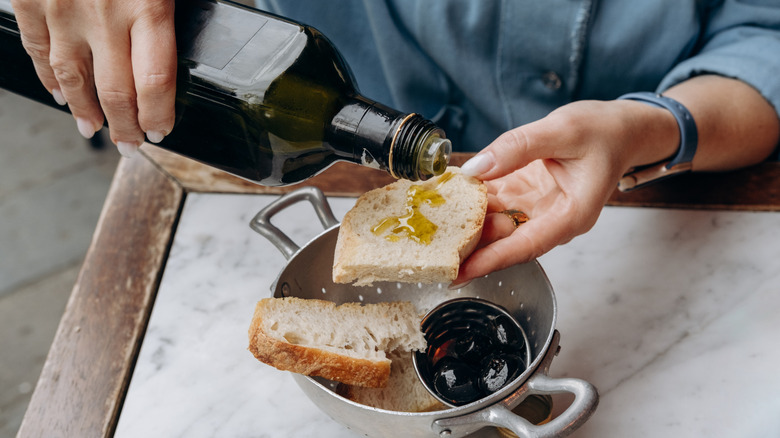If The Olive Oil Bottle At A Restaurant In Italy Looks Like This, You Might Want To Leave
Italy is a country with deep roots, heritage, and a strong, evident culture that's hard to miss. This culture can easily be spotted in the way locals interact with each other, the traditions, and, of course, the irresistible food. While pasta and pizza are staples of Italian cuisine, one of the most essential ingredients is olive oil. Apart from the classic trio of bread, olive oil, and balsamic vinegar found in every Italian restaurant, olive oil is added to nearly every savory recipe in Italian cuisine. The next time you dine in an Italian restaurant in Italy, be sure to keep an eye on the bottle to help determine if the olive oil being served is authentic or a cheap knockoff. In fact, if you find no label and a flag on the bottle or that the bottle is transparent instead of tinted, it's an indication that you should get up and leave because the food in this restaurant will be far from using authentic Italian ingredients.
Olive oil red flags to look out for
Unless a grandma is in charge of the restaurant and cultivates the olive oil herself, the first red flag to look out for is a reused or unlabeled olive oil bottle. The more authentic the restaurant, the more likely you are to see sealed, original olive oil bottles on every table. If these are replaced with unlabeled bottles, it may indicate that lower-quality olive oil is being used.
If you're an olive oil expert, you'll know this essential ingredient should not be exposed to light or heat. So, the next red flag signaling poor-quality olive oil to avoid is its placement next to a heat source or under strong lights. Olive oil degrades, accelerating the oxidation process when exposed to heat or light, which causes it to completely lose its nutritional value. That's why most olive oil bottles are tinted or dark to prevent exposure. Sometimes, even clear bottles can be the giveaway you need to avoid a restaurant at all costs.
Laws in Italy also require that olive oil be served in tamper-proof packaging to ensure its authenticity and prevent contamination. This is an even more important reason to avoid a restaurant that does not comply, as it may indicate a disregard for food safety standards. Is that really the restaurant you'd want to dine in as a tourist?
How to spot quality and choose the right restaurant in Italy
If you're looking for quality, you should pay attention to the olive oil being used. According to the latest EU laws, restaurants are required to use sealed and labeled bottles with the country of origin listed on the bottle. Sometimes, a premium bottle will have a DOP or IGP certification, which indicates the olive oil's origin and quality. You should always make sure the bottle is tinted and dark, preserving its quality for longer periods. Restaurants following these simple olive oil regulations show that they value food quality, origin, and safety regulations and have a commitment to serving the best ingredients possible.
If you're looking for an authentic Italian meal with the best ingredients, your olive oil needs to be top-notch. The question is: When should you walk away? As a tourist, you have limited dining days, and you should savor the best and skip the rest. The biggest red flags in an Italian restaurant that should be avoided are reused or unlabeled olive oil bottles. Poor-quality olive oil bottles will likely be an extension of the disappointing dining experience you'll have if you should choose to dine. After all, olive oil is a staple in Italian cuisine, and low-quality olive oil likely indicates a disappointing experience.


